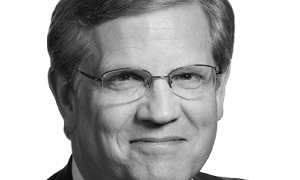The world has changed greatly since the heyday of USAID in the 1960s. Today private capital flows dwarf official foreign assistance provided by governments. As a result of these very positive global economic developments, U.S. assistance does not have the market share and influence it once did. The need to support America’s goals and policies, however, remains undiminished.
Properly designed and directed, U.S foreign aid can support U.S. national interests. It can address humanitarian crises, promote policy changes necessary for private-sector-led economic growth that is the most reliable and sustainable path to development, or advance our diplomatic and security priorities through targeted support.
Unfortunately, many of America’s current aid programs are not fit for this purpose. It is no longer feasible merely to propose patches and workarounds to the 1961 Foreign Assistance Act which was, itself, a restructuring of awkward, haphazard, and ineffective post-war programs from the 1950s that had become increasingly bogged down by bureaucratic fragmentation and infighting.
Other developed countries — such as Sweden, Norway, Denmark, and Canada — are way ahead of the U.S. and have already merged their foreign aid and diplomatic agencies. The result is a more coherent approach to foreign policy.
By the same logic, the American president’s ambassador to a country should have greater authority over foreign aid expenditures in that country. With all due respect to former United States Agency for International Development (USAID) Administrator Andrew Natsios, he had it completely backwards when he told Foreign Policy magazine in April 2017 that “USAID’s mission directors are among the most influential foreigners in the country.”
In fact, just the opposite should be the case. For U.S. development assistance to become more effective, the ambassador should be seen as the “go-to” person for assistance projects.
On Sept. 15, the Trump administration’s high-level task force of officials from the State Department and USAID will submit a much needed plan to the Director of the Office of Management and Budget to restructure America’s foreign assistance programs.
To assist them, The Heritage Foundation will soon publish a detailed background report with extensive analysis of the current dysfunctional state of U.S. government foreign assistance programs and detailed recommendations on how to fix them.
Here are some highlights of that forthcoming report — 13 recommendations to reform U.S. foreign aid:
1. Eliminate duplicative foreign aid programs, improve coordination of remaining programs, end congressional “earmarks,” and terminate programs that do not work.
2. Replace USAID with a new “United States Health and Humanitarian Assistance Agency” (USHHAA) to manage all health and humanitarian assistance programs.
3. Fully integrate USHHAA into the State Department, with the USHHAA administrator reporting to the secretary of state as the under secretary of state for foreign assistance.
4. Merge State and USAID administrative functions in Washington and in the field. Put USAID’s Foreign Service Officers into a new “Assistance Cone” at State and consider more far-reaching reforms of the Foreign Service to give the U.S. government more flexibility to respond to future challenges.
5. Move all development assistance to the Millennium Challenge Corporation (MCC), an independent agency that stresses the primary importance of the rule of law, effective governance, and recipient country accountability.
6. Transfer USAID’s Development Assistance account to the MCC and add the under secretary of state for foreign assistance to the MCC Board of Directors to better coordinate all U.S. foreign assistance.
7. Eliminate the under secretary of state for civilian security, democracy and human rights, and eliminate or move its offices, bureaus, and responsibilities to other parts of the State Department or to USHHAA.
8. Eliminate the State Department’s Bureau of Population, Refugees and Migration (PRM) and transfer policy responsibilities to the regional bureaus and the refugee assistance responsibilities to USHHAA.
9. Ensure that all other U.S. foreign aid programs at agencies as diverse as Justice, Interior, or Agriculture are coordinate and consult with the under secretary of state for foreign assistance. Technical or specialized assistance, such as responding to pandemics, should be led by the experts but coordination is critical to ensuring effective broader application of U.S. government resources.
10. End the role of the Department of Agriculture in food assistance by terminating the P.L. 480 program, with its inefficient shipping and purchase requirements. Give USHHAA full authority over all U.S. food assistance.
11. Eliminate outdated agencies such as the Export-Import Bank of the United States, the United States Trade and Development Agency, and the Overseas Private Investment Corporation. These agencies were established in a world where private investment in developing countries was scarce. This is no longer the case. The focus should be to encourage developing countries to access these resources based on their policies, not send the message that government subsidies are necessary for development.
12. Re-designate the State Department’s Economic Support Fund account as the “Policy Goal Implementation Fund” with the express purpose of generating goodwill and support for U.S. foreign policy and security objectives, including promoting resilient, democratic, prosperous and secure societies around the world.
13. Better coordinate military and security assistance under the joint authority of the Departments of Defense and State.
Elected officials have a responsibility to use American taxpayer dollars prudently and efficiently to support U.S. national interests. Although some reforms have been enacted in recent years during the Bush and Obama administrations, the underlying problems remain.
The interest of the Trump administration in reforming America’s foreign aid programs is an opportunity that should not be squandered. Fundamental reform is not within the sole authority of the Executive Branch to implement, however; legislation to amend or replace existing laws is required. The Trump administration should consult with Congress early and often to take congressional concerns and priorities into account and work jointly to reform, consolidate, and refocus U.S. foreign assistance programs to maximize their effectiveness for the future, not the past.
This piece originally appeared in The Hill on 8/25/2017

